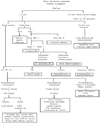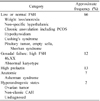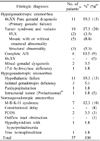Abstract
A complete interaction in the hypothalamic-pituitary-ovary-uterus (H-P-O-U) axis must take place in order for normal menstruation occurs. If any of the components in the H-P-O-U axis are nonfunctional, amenorrhea could occur. The prevalence of amenorrhea not due to pregnancy or lactation is approximately 3% to 4% in reproductive women. Because there are many causes of amenorrhea, the clinicians should be concerned with array of potential diseases and disorders involving unfamiliar organ systems, some carrying morbid and even lethal consequences for the patients. To explore the causes of amenorrhea, thorough evaluation of H-P-O-U axis and endocrinologic profiles are needed. The etiologic diagnosis is almost always possible with proceeding step by step approaches.
Figures and Tables
 | Fig. 1Diagnostic approach in patient with amenorrhea. M-R-K-H: Mayer-Rokitansky-Küster-Hauser syndrome, AIS: androgen insensitivity syndrome, LH: luteinizing hormone, FSH: follicle stimulating hormone, TSH: thyroid stimulating hormone, DHEA-S: dehydroepiandrosterone sulfate, POF: premature ovarian failure, PCOS: polycystic ovary syndrome. |
Table 3
Common causes of secondary amenorrhea (From Practice Committee of American Society for Reproductive Medicine. Fertil Steril 2008; 90: S219-25, with permission from Elsevier).40

References
1. Speroff L, Fritz MA. Speroff L, Fritz MA, editors. Amenorrhea. Clinical gynecologic endocrinology and infertility. 2005. 7th ed. Philadelphia: Lippincott Williams and Wilkins;402–463.
2. Herman-Giddens ME, Slora EJ, Wasserman RC, Bourdony CJ, Bhapkar MV, Koch GG, et al. Secondary sexual characteristics and menses in young girls seen in office practice: a study from the Pediatric Research in Office Settings network. Pediatrics. 1997. 99:505–512.
3. Frisch RE, McArthur JW. Menstrual cycles: fatness as a determinant of minimum weight for height necessary for their maintenance or onset. Science. 1974. 185:949–951.
4. Lucas AR, Crowson CS, O'Fallon WM, Melton LJ 3rd. The ups and downs of anorexia nervosa. Int J Eat Disord. 1999. 26:397–405.
5. Welt CK, Chan JL, Bullen J, Murphy R, Smith P, DePaoli AM, et al. Recombinant human leptin in women with hypothalamic amenorrhea. N Engl J Med. 2004. 351:987–997.
6. Rosenfield RL. Clinical review 6: diagnosis and management of delayed puberty. J Clin Endocrinol Metab. 1990. 70:559–562.
7. Hall JE. Physiologic and genetic insights into the pathophysiology and management of hypogonadotropic hypogonadism. Ann Endocrinol (Paris). 1999. 60:93–101.
8. Oliveira LM, Seminara SB, Beranova M, Hayes FJ, Valkenburgh SB, Schipani E, et al. The importance of autosomal genes in Kallmann syndrome: genotype-phenotype correlations and neuroendocrine characteristics. J Clin Endocrinol Metab. 2001. 86:1532–1538.
9. Perkins RB, Hall JE, Martin KA. Aetiology, previous menstrual function and patterns of neuro-endocrine disturbance as prognostic indicators in hypothalamic amenorrhoea. Hum Reprod. 2001. 16:2198–2205.
10. Herzog DB, Copeland PM. Eating disorders. N Engl J Med. 1985. 313:295–303.
11. Mehler PS. Clinical practice. Bulimia nervosa. N Engl J Med. 2003. 349:875–881.
12. Olson BR. Exercise-induced amenorrhea. Am Fam Physician. 1989. 39:213–221.
13. Highet R. Athletic amenorrhoea. An update on aetiology, complications and management. Sports Med. 1989. 7:82–108.
14. Berek JS. Berek JS, editor. Amenorrhea. Berek and Novak's Gynecology. 2006. 14th ed. Philadelphia: Lippincott Williams and Wilkins;1035–1067.
15. Layman LC, McDonough PG, Cohen DP, Maddox M, Tho SP, Reindollar RH. Familial gonadotropin-releasing hormone resistance and hypogonadotropic hypogonadism in a family with multiple affected individuals. Fertil Steril. 2001. 75:1148–1155.
16. Beranova M, Oliveira LM, Bedecarrats GY, Schipani E, Vallejo M, Ammini AC, et al. Prevalence, phenotypic spectrum, and modes of inheritance of gonadotropin-releasing hormone receptor mutations in idiopathic hypogonadotropic hypogonadism. J Clin Endocrinol Metab. 2001. 86:1580–1588.
17. Layman LC, Lee EJ, Peak DB, Namnoum AB, Vu KV, van Lingen BL, et al. Delayed puberty and hypogonadism caused by mutations in the follicle-stimulating hormone beta-subunit gene. N Engl J Med. 1997. 337:607–611.
18. Rosen GF, Kaplan B, Lobo RA. Menstrual function and hirsutism in patients with gonadal dysgenesis. Obstet Gynecol. 1988. 71:677–680.
19. Rhee JH. Clinical investigation of primary amenorrhea. Korean J Obstet Gynecol. 2002. 45:1045–1051.
20. Turner's syndrome. West J Med. 1982. 137:32–44.
21. Baughman FA Jr, Vander Kolk KJ, Mann JD, Valdmanis A. Two cases of primary amenorrhea with deletion of the long arm of the X chromosome (46, XXq-). Am J Obstet Gynecol. 1968. 102:1065–1069.
22. Therman E, Susman B. The similarity of phenotypic effects caused by Xp and Xq deletions in the human female: a hypothesis. Hum Genet. 1990. 85:175–183.
23. Zinn AR, Tonk VS, Chen Z, Flejter WL, Gardner HA, Guerra R, et al. Evidence for a Turner syndrome locus or loci at Xp11.2-p22.1. Am J Hum Genet. 1998. 63:1757–1766.
24. Ferguson-Smith MA. Karyotype-phenotype correlations in gonadal dysgenesis and their bearing on the pathogenesis of malformations. J Med Genet. 1965. 2:142–155.
25. Cotinot C, Pailhoux E, Jaubert F, Fellous M. Molecular genetics of sex determination. Semin Reprod Med. 2002. 20:157–168.
26. Park J, Kim J, Rhee J. A case of gonadoblastoma in patient with mixed gonadal dysgenesis. Korean J Obstet Gynecol. 2002. 45:1204–1208.
27. Kim MJ, Kim HJ, Ryu SJ, Kim JI, Rhee JH. Two cases of recovery of ovarian function and spontaneous pregnancy in women who were diagnosed as premature ovarian failure. Korean J ObstetGynecol. 2000. 43:145–149.
28. Murray A. Premature ovarian failure and the FMR1 gene. Semin Reprod Med. 2000. 18:59–66.
29. Allingham-Hawkins DJ, Babul-Hirji R, Chitayat D, Holden JJ, Yang KT, Lee C, et al. Fragile X premutation is a significant risk factorfor premature ovarian failure: the International Collaborative POF in Fragile X study--preliminary data. Am J Med Genet. 1999. 83:322–325.
30. Park JC, Kim JI, Rhee JH. Association with autoimmune disease in patients with premature ovarian failure. Korean J Fertil Steril. 2004. 31:149–154.
31. Kim MH. "Gonadotropin-resistant ovaries" syndrome in association with secondary amenorrhea. Am J Obstet Gynecol. 1974. 120:257–263.
32. Bose HS, Sugawara T, Strauss JF 3rd, Miller WL. The pathophysiology and genetics of congenital lipoid adrenal hyperplasia. N Engl J Med. 1996. 335:1870–1878.
33. Park KY, Park KL, Rhee JH. A case of 17a-hydroxylase deficiency in 17-year-old girl. J Kor Soc Endocrinol. 1996. 11:102–107.
34. Bulun SE. Clinical review 78: Aromatase deficiency in women and men: would you have predicted the phenotypes? J Clin Endocrinol Metab. 1996. 81:867–871.
35. Mullis PE, Yoshimura N, Kuhlmann B, Lippuner K, Jaeger P, Harada H. Aromatase deficiency in a female who is compound heterozygote for two new point mutations in the P450arom gene: impact of estrogens on hypergonadotropic hypogonadism, multicystic ovaries, and bone densitometry in childhood. J Clin Endocrinol Metab. 1997. 82:1739–1745.
36. Latronico AC, Anasti J, Arnhold IJ, Rapaport R, Mendonca BB, Bloise W, et al. Brief report: testicular and ovarian resistance to luteinizing hormone caused by inactivating mutations of the luteinizing hormone-receptor gene. N Engl J Med. 1996. 334:507–512.
37. Latronico AC. Naturally occurring mutations of the luteinizing hormone receptor gene affecting reproduction. Semin Reprod Med. 2000. 18:17–20.
38. Tapanainen JS, Vaskivuo T, Aittomaki K, Huhtaniemi IT. Inactivating FSH receptor mutations and gonadal dysfunction. Mol Cell Endocrinol. 1998. 145:129–135.
39. Park JC, Shin SJ, Kim JI, Rhee JH, Kim TH. A successful uterine surrogate pregnancy via oocyte retrieval through the neovagina in a patient with Mayer-Rokitansky-Küster-Hauser syndrome. Korean J Obstet Gynecol. 2003. 46:681–684.
40. Current evaluation of amenorrhea. Fertil Steril. 2008. 90:5 Suppl. S219–S225.
41. Kim JI, Rhee JH, Eun MH. A case of complete androgen insensitivity syndrome with bilateralinguinal gonads. Korean J Obstet Gynecol. 1999. 42:632–636.
42. Kim PJ, Lee EW, Zo NG, Rhee JH. A case of complete androgen insensitivity syndrome which gonadectomy had been performed by pelviscope. Korean J Obstet Gynecol. 1996. 39:1568–1575.
43. Peterson RE, Imperato-McGinley J, Gautier T, Sturla E. Male pseudohermaphroditism due to steroid 5-alpha-reductase deficiency. Am J Med. 1977. 62:170–191.
44. Bachmann GA, Kemmann E. Prevalence of oligomenorrhea and amenorrhea in a college population. Am J Obstet Gynecol. 1982. 144:98–102.
45. Reindollar RH, Novak M, Tho SP, McDonough PG. Adult-onset amenorrhea: a study of 262 patients. Am J Obstet Gynecol. 1986. 155:531–543.
46. Reindollar RH, Byrd JR, McDonough PG. Delayed sexual development: a study of 252 patients. Am J Obstet Gynecol. 1981. 140:371–380.




 PDF
PDF ePub
ePub Citation
Citation Print
Print




 XML Download
XML Download